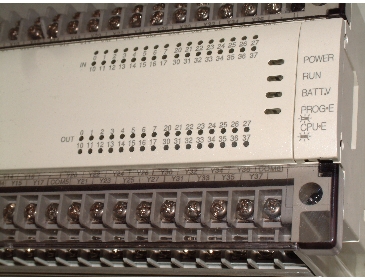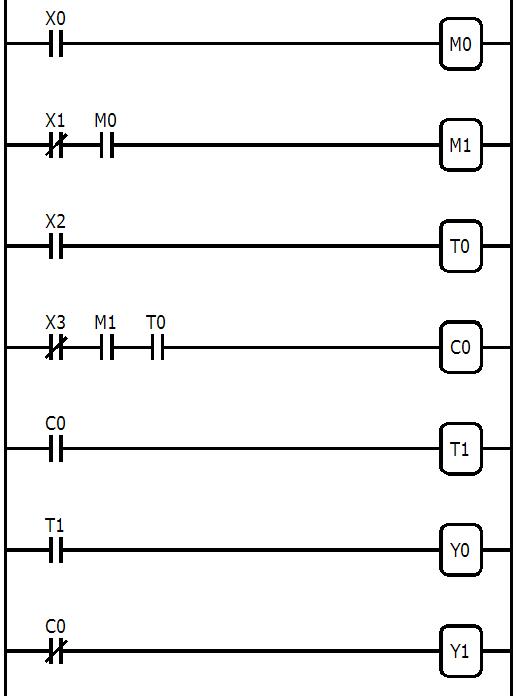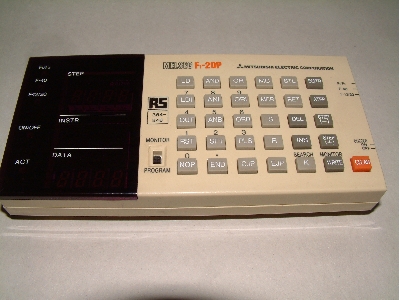|
PLC HISTORY
The concise PLC History
PLC History and the origins of how they came to be! Incidentally you can also find out what makes a PLC tick and how PLCs work here. Or, maybe our PLC Tutorial could be what you're looking for. If we delve back into the history of the PLC, or more to the point, the history of before PLC's came to be. The only (or rather the best) way to control a production machine (or any other type of machine for that matter) was to make up a control circuit with something called relays.
Relays work by creating a magnetic force with power applied to it (the coil). This magnetic force is how the relay is mechanically switch over. Electrical power applied to the coil creates an electromagnet, the electromagnet pulls or pushes a bar with the switch contacts attached. This type of operation is referred to as an 'Electromechanical' method of control.
Basically a relay is an electrically powered switch. A relay has two main parts, a coil and switch contacts, normally several separate sets of switch contacts. The coil is like an electrical push-button, applying power to the coil, like 24 Volts DC, operates the switch contacts. Removing the power lets the switch contacts fall back to the rest or OFF position. Applying and removing power thus gives an ON/OFF action (or OFF/ON action for normally closed contacts).
Relays that switch motors and solenoids are generally called power relays, because... well, basically they control the power by switching a sizable voltage and current on and off. Consequentially so, controlling the motor, heater, valve or solenoid wired through them. OK so far? (good)
As you can imagine on a machine with many motors and solenoids (posh word for electromagnet) and valves to control, this would take many relays and switch contacts. Quite often did, several electrical cabinets of them.
BUT what switches the coils on the power relays?
Oh yes more relays, these relays, who's job it is to control the power relays are called control relays. Not much imagination used here then but never-less quite logical.
All these these relays had to be hard wired together in the right order in a control panel to make the machine operate in the desired manor. This style of control panel gave rise to several problems, as the relays were electromechanical they failed far too often.
Coil failure and contact wear were difficult to diagnose and replace, also if a circuit change was needed that called for an extensive rewire of all the involved relays. Also, a panel with dozens, even hundreds of relays consumed oodles of power.
So one fine day a smart gentleman called Richard E. Morley, an employee of Bedford Associates (Bedford, MA) involved in the automotive industry, proposed something called a Modular Digital Controller (MODICON) to a major US car manufacturer. So thereby invented the first Programmable Logic Controller (Aha the PLC), started as a consultation project for the General Electric Company in 1968, thus PLC history was born.
The primary reason for designing such a device was eliminating the large cost involved in replacing the complicated relay based machine control systems. Because as production demands changed so the relay control panels had to be changed. Wire by wire, relay by relay and more often than not replaced completely with a new control panel.
After the PLC took off, which didn't take very long given the advantages, Bedford Associates changed their name after some time to Modicon PLC and eventually became the first supplier of PLC’s.
The commercial version didn’t come along until several years later of course. The MODICON 084 brought the world's first PLC into commercial production. This then presented another problem to overcome, how to program them.
They didn’t have PLC tutorials in those days of course, so Mr Morley purposely, had to make the PLC easy to understand and program for the technicians and maintenance electricians of the day.
These technicians and maintenance electricians were already very used to relay schematics and wiring, which was and is a skilled position to hold.
PLC Ladder program/relay schematic
This is why PLC history is so deeply rooted in this relay schematic layout, the Ladder Logic (as it’s now called) schematic style of operation was copied into the PLC programming software as a basis of programming.
Now would you be surprised to know that Ladder Logic is still by far the most popular way to program PLC’s today? Of course you wouldn't, it is.
Nowadays PLC’s are still programmed in Ladder Logic via a desktop computer or laptop in the field, but back then computers as we know them now weren’t around. The programming of these ingenious devices had to be done to start with, something call a hand-held programmer.
These programmers weren’t actually always hand-held, some were just too large to hold and use and connected via a cable. Others of them would be clipped onto the front of the PLC itself to program the PLC.
PLC Ladder programmer Just like this one here, although it's not that old (only about 20 years or so) it is very rare now and cannot be purchased any more through the normal channels.
This particular programmer is a Mitsubishi F1-20P and to use it you would be entering or editing one relay switch or coil at a time.
Quite laborious as you can imagine, especially if your prospective program is upwards of 50 steps long or more (one step is a relay switch or coil). I've used these hand held programmers way back in the past I can tell you with certainty it was difficult as most programs tended to be in the order of the thousands of steps long!
These days PLC's form the central hub of many manufacturing processes and machines operation. These microprocessor based boxes of electronics are used everywhere in industry from simple machine projects such as one operation filling and box packing machines at one end of the scale.
Right up to the tracking and control of very highly sophisticated, fully automated warehouse systems. You will find them in virtually all new and most existing manufacturing, processing, printing and packaging machine equipment. So it won’t surprise you for me to tell you in this PLC history article, that because of their popularity being so widespread in industry. It has become increasingly more and more important for technicians to learn the skills needed to use and find fault with these wonderful devices. And what makes them tick!
Speaking of ticking, the bit in all of these little beasties that does the ticking is the Microprocessor. The microprocessor or the processor module is the brain in the box, but nowadays microprocessors are a far cry from the 1960’s microprocessors. There is a microprocessor bringing this PLC history to your screen of course.
In essence the job of the microprocessor is to monitor the condition or state of the inputs, use this data in performing the logic of the user program and then update the state of the outputs accordingly. Some PLC’s only have as little as 6 inputs and outputs (referred to as I/O) in total to control, but others can have in the order of forty thousand or more I/O.
One single PLC processor is capable of controlling just one process or a whole manufacturing empire, even internationally. Quite an easy job when there’s only 6 inputs and outputs, but when there’s around forty thousand . . . WOW!!!
Not completely on its own though as these days PLC processors can be networked, one main processor would then control others that do the local work and report back to the mian controlling PLC processor.
I have included here a little bit more on PLC history by the man himself, Richard E. Morley. Please read through it as I have but it may not be as accurate as officially recorded PLC history, they are said to be the best recollections that an Alzheimer plagued memory can do.
Go from PLC History back to PLC Tutorial page.
Return from PLC History to Home page.
PLEASE feel free to use this button and donate You Are Secure!
so Machine-Information-Systems.Com can keep helping you.
|


